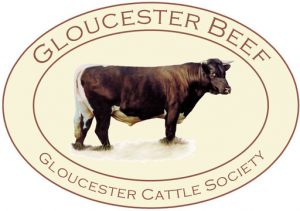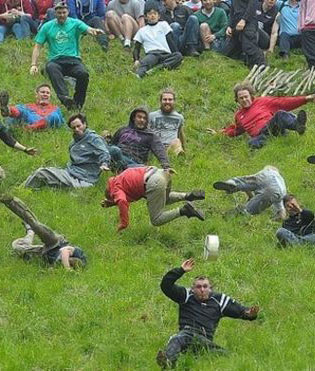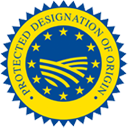Gloucester Beef
Gloucesters are officially classified as a Dual Purpose Breed and are eligible for the Suckler Cow Premium and Beef Special Premium Schemes.
Gloucester cattle produce a good carcase of excellent flavour. Good marbling and fat cover enhance cooking qualities. Slowly grown and simply fed on extensive systems, the meat is hung for up to four weeks to bring out the very best of the flavour and tenderness.
‘Gloucester Beef’ is registered and refers to beef from Pedigree Gloucester cattle.

REGULATIONS GOVERNING THE USE OF THE GLOUCESTER CATTLE SOCIETY’S BEEF CERTIFICATION MARK
Who is Authorised to use the Mark
The authorised users of the Certification Mark are Members of the Gloucester Cattle Society (hereafter called the society) who have paid their annual subscription to the Society and other persons who have been licensed by the Council of the Gloucester Cattle Society to use the mark.
2. Conditions of Membership of the Gloucester Cattle Society
Membership of the Society shall be open to:
Individuals (over the age of 18) who are interested in furthering the work of the Society and who have paid an annual subscription laid down from time to time by the Council; and
Any body corporate or unincorporated association which is interested in furthering the Society’s work and has paid an annual subscription (any such body being called in these memorandum a “member organisation”); and
Juniors (under the age of 18 years) who are interested in learning about and furthering the work of the society.
3. Conditions of Use of the Mark
The mark may be used by members of the Gloucester Cattle Society and by other licensed users in relation to Meat and products containing meat; all being from pedigree Gloucester cattle or their pure bred progeny.
The mark may be used by members of the Gloucester Cattle Society only in relation to pedigree Gloucester cattle or their pure bred progeny
4. Sanctions Against Misuse
Members and other licensed users found to be misusing the mark by misrepresenting the Products or Livestock will have their licence to use the mark revoked.
Non members and others illegally using the mark will be prosecuted.
Details of the misuse of the mark will be published in the Society’s newsletter and/or press as appropriate
5 . The Characteristics of the Mark
Use of the Certification Mark will certify that the cattle are pure bred Gloucester Cattle or progeny of pure bred Gloucester Cattle and that the meat and products containing or incorporating meat, contain only meat that is from pure bred Gloucester Cattle.
6 . How the Certification Body is to Test those Characteristics and Supervise the use of the mark
The society will license members and others to use the mark and will monitor its use. The society will also request that members bring to its attention any breeches in its use.
The society’s test for compliance with the characteristics of the mark will be the record of the entry of the product certified in the Society’s Herd Book, for a registered pedigree animal, or the birth notification record in the case of an animal that is pure bred and either has not been fully registered or is not eligible for pedigree registration under the society’s rules
In cases of dispute or miss-representation the Society will, where possible carry out DNA testing of the products to establish and confirm its origin.
The cost of the DNA testing shall be borne by the producer, unless the testing confirms that the product correctly meets the Certification criteria. In such cases the cost of the DNA testing shall fall to the Society.
The Fees to be paid in connection with the operation of the mark
For members of the Gloucester Cattle Society, the payment of the Society’s annual subscription (currently £50) will be deemed to be the licence fee to use the mark for that year. No additional fees will be required.
For other users an annual usage fee of £60 will be charged.
The procedure for resolving disputes
Should a dispute arise between the Gloucester Cattle Society as Proprietor of the Certification Mark and an Authorised user, then the dispute will be referred to an arbitrator, whose appointment shall be agreed to by both parties
9. An amendment of the regulations governing the use of a registered certification mark is not effective unless and until the amended regulations are filed with the registrar and acceptedby him.
Cheese Making
Gloucester is a traditional, semi-hard cheese which has been made in Gloucestershire, since the 16th century.
There are two types of Gloucester cheese: Single and Double; both are traditionally made from milk from Gloucestershire breed cows farmed within Gloucestershire.
Both types have a natural rind (outer layer) and a hard texture, but Single Gloucester is more crumbly, lighter in texture and lower in fat. Double Gloucester is allowed to age for longer periods than Single, and it has a stronger and more savoury flavour. It is also slightly firmer. The flower known as Lady’s Bedstraw (Galium verum), was responsible for the distinctively yellow colour of Double Gloucester Cheese. In the United Kingdom today, of these two types of cheese, it is the “Double Gloucester” which is more likely to be sold in supermarkets. Both types are produced in round shapes, but Double Gloucester rounds are larger. Traditionally whereas the Double Gloucester was a prized cheese comparable in quality to the best Cheddar or Cheshire, and was exported out of the County, Single Gloucester tended to be consumed within Gloucestershire.
Single Gloucester has a Protected Designated Origin (P.D.O.) and can only be made in Gloucestershire using the milk from a dairy herd containing Gloucester cattle.
Most Double Gloucester sold in UK supermarkets is slab cheese, made in large creameries operated by major dairy companies such as Dairy Crest. It is normally sold as a supermarket own brand. This version of the cheese is pasteurised.

Cheese Rolling
Rounds of Double Gloucester cheese feature in the Cooper’s Hill Cheese-Rolling and Wake, a risky sport due to the length (200 yards), and 50% gradient of the steep Gloucestershire hillside.
The event attracts media attention from all over the world …. and paramedics
Origin of double and single names
The reason is not actually known! The main theories are:
because the creamy milk had to be skimmed twice to make the double variety, or because cream from the morning milk was added to the evening milk, or because a Double Gloucester cheese is typically twice the height

